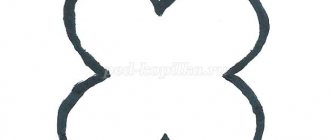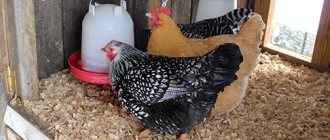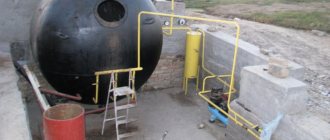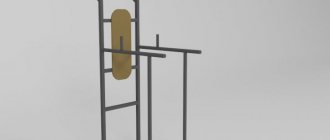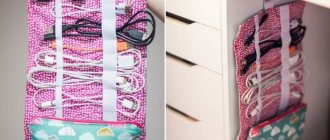DIY electric car for children, Project No. 2
DIY electric car for children
How we made an electric car 2
and here it is - the continuation.
We drove the first car for two seasons (now it is gathering dust in the garage). At first she seemed so beautiful, but now, having soberly assessed her appearance, we are horrified. My son has grown up, his view on the aesthetic side of the car has changed, maybe there are some other reasons, but car 1 was no longer suitable, but he wants to ride... As usual, my parents don’t have money (no, we’re not greedy, prices just went up again). In short, it's time to make car-2.
There were several nuances: 1. The car had to be as large and powerful as possible and at the same time fit into an ordinary elevator, fit through the doors of an ordinary apartment and be light. 2. Consume little energy. 3. Be beautiful. 4. Other incompatible requirements. 5. The total power of the engines is at least 180 watts. 6. Having experience with car 1, it was decided that brakes are a MUST. 7. Smooth “gas”, i.e. an electronic engine control circuit was needed. 8. Inflatable wheels.
250 watt (very tempting in terms of power) from UAZ or Volga were not suitable for two reasons. 1. expensive (1000 rubles per piece). 2. current consumption is quite large.
There were 110 watt ones left from VAZ, and they were bought for 450 rubles. per piece
After purchasing the engines, the question became, how will the torque be transmitted to the wheels?
After numerous experiments, it was decided that the rubber band was cut from the inner tube of a passenger car. And therefore, pulleys for the wheels and for the engine were ordered from the turner at the factory. According to the drawing I gave. The turner was a MONSTER and from a sheet of iron using a machine and a torch he created these pulleys
I want to warn those who will repeat my actions. As it turned out, for a flat belt drive you need BARREL-SHAPED pulleys, otherwise the belt crawls out from the pulleys... I didn’t want to redo anything and didn’t intend to and got out of this situation by cutting one wide belt into 4 thin ones
The circuit of the entire car was modified for use as an engine regulator; some elements were added. The power transistor was placed on the heatsink from the processor.
Steering wheel...needed a small steering wheel...where to get one? We thought of all sorts of thoughts, but we had to go to the car market and fork out 500 rubles. like a real sports steering wheel from a real car.
Now we need to buy additional plywood, more bolts, radio components, sensors... well, a lot of other small things... And some of them you can’t find in our city at all - you have to order them. Weld the pedals..., buy paint, work, horror in short.
But now you can cook the frame!
Park and slowly assemble the car.
More than one day was also spent on the electrical circuit.
After sawing off the excess and filing it, we took it to the garage.
We are already in the garage (the mother kicked the children out of the house so as not to stink of paint) priming the car. All that remains is to pull the pieces of rubber hose onto the bumpers (dear dog)
and install a bike computer (shows speed, distance traveled....and a bunch of all sorts of data...the wheel size is adjustable, so it shows quite accurately),
and install a 75 A/h battery,
Source
Do-it-yourself single-seater velomobile
Velomobile made from an old bicycle
To implement this idea you will need:
- bike;
- 2 meters of steel pipe with a diameter of 2.5 cm;
- 6 meters of profile pipe with a cross section of 3.8 * 3.8 cm;
- profile pipe with a cross section of 2.5*2.5 cm (about 3.5 m);
- profile pipe with a cross section of 1.3*1.3 cm (about 1.5 m);
- steel plate 0.47 cm thick;
- Chipboard, foam rubber, seat upholstery;
- bolts, nuts, seat upholstery, primer.
The frame of the velomobile is made of profile pipes
Such a velomobile, of course, looks powerful, but you have to pay for it with the lightness of the design. There will be an opportunity to pump up your legs well. In addition, there are suspicions that the main load will fall on the weld, which is located closer to the steering wheel. All this will lead to the fact that one day the frame will not hold up and burst at the seam.
It is worth noting that the idea with the front drive wheel was implemented well. Please note that the drive sprocket, which was previously located at the rear, now needs to be turned over. We also turn the switch upside down and install it further 5.7 cm and 0.15 cm higher. The bracket on which everything will rest is made of a steel plate.
For the speed derailleur to work correctly, it must be installed upside down
The hardest part is over. If you get this done, there shouldn't be any problems with the rear of the velomobile.
The velomobile can now stand on its own wheels
As you noticed, you will need a third wheel. You can carefully take it from a neighbor while he is resting after a heavy lunch, but it is better not to risk it and warn him in advance. Many will be glad to get rid of junk.
We make the rear wheel mounts from a steel plate
Next we should move on to the brakes. Of course, “what Russian doesn’t like driving fast.” Besides, everyone has long known that brakes were invented by cowards. But let's think about those around us. Can you imagine what will happen to a person when such a machine hits him? So, brakes. We simply transfer them from the remains of our old bicycle. We weld the brake caliper to the new front fork and transfer the brake mechanism to it.
Weld the brake caliper to the front fork
We make the frame of the future seat from a metal profile.
Three sections connected by bolts will allow us to adjust the seat back and headrest
The base of the seat and back are made of chipboard and foam rubber. We choose the softness ourselves, as well as the upholstery.
Once you've finished celebrating the completion of the work, be sure to test drive the velomobile
Test drive of a single-seat velomobile - video
Advantages of this design:
- convenience and safety compared to a bicycle;
- uniqueness;
- several speed modes.
What is the difficulty of creating a children's electric car from scratch?
The main design goal when creating a children's electric car is to ensure the reliability of the product with optimal dimensions and weight. A heavy, substantial-sized device will be too heavy for a child and his mother to lift, and will also cause a lot of trouble with transportation in an elevator and storage. Also, a bulky body requires a more powerful engine and a larger battery, and this again entails weight and requires strengthening of the frame and chassis.
The design of the body or frame on which all components and mechanisms are supported is the work of engineers. And therefore, when assembling a homemade children's electric car, you can significantly simplify your task by using a ready-made design for a children's car with pedals or an ordinary pusher.
If, nevertheless, looking for easy ways is not for us or we plan to get a powerful base with the possibility of later converting it into a teenage go-kart or buggy, on the Internet you can find a variety of drawings according to which you can make a children’s electric car.
But the best option would be to create your own, taking into account the selected components and materials. Having basic design skills, you can create an optimal model with all the characteristics, and even design it according to the order of the young driver.
DIY children's car made of wood
This is, of course, an option for parents. A child cannot handle making such a toy. Although parents may well ask older children for help. To create a car you will definitely need a set of carpentry equipment and tools and lumber.
If you are planning a fairly compact structure, then it is best to buy 5*5 cm bars and 7*5 cm boards. For benches, take an edged board at least 2 cm thick.
If possible, install the steering wheel so that it can rotate. A steering wheel from a real car with a speaker is suitable for this.
The wheels can be made from plywood or use old tires.
It is advisable to use galvanized sheet metal to cover the hood and roof of the cabin, and boards or thick plywood for the bottom. Don’t forget to paint the finished children’s wooden car with your own hands, or better yet, involve your child in this process. He'll have a lot of fun painting together.
.
Manufacturing sequence
First, let's decide on the design, because for children, appearance is very important. There are no restrictions here, and if we make the body ourselves, we can copy it from any children’s or adult’s car. In addition, you can develop a design in the form of an airplane, ship, rocket or some other animal.
We will think over the type of control, steering and brake mechanisms, select components from those available on the farm or available for sale.
Next, we assemble all the components together, for fastening we use the necessary screws, angles, clamps, you can resort to welding or soldering the seams.
It is advisable to make the frame more compact, taking into account the dimensions of all components, with reliable joining of the elements. Thus, the car will be stronger, more maneuverable and lighter, this will allow you to get by with a simpler motor and battery.
What to make the body out of
Traditionally, kids' car frames have been made from steel or wood by dads for centuries. But now more modern materials are available, which are in no way inferior to metal in construction. For example, from PVC pipes you can easily cut and solder a strong base that can withstand heavy weight, vibrations and shocks: cutting and soldering this material is not difficult, the corners will be smooth, injury-proof, and the structure will not make noise when driving.
Selecting an electric motor
The engine for an electric vehicle can be selected from any equipment powered by a voltage of 12-24 volts, for example, car engines.
For the smallest children - on pushers - a windshield wiper gear motor is suitable, developing a decent traction force at a speed of 1-2 km/h with a power of only 7-20 W.
For fast driving you will already need motors from 100 W, for example, from a cooling system fan. A motor made from a screwdriver is also perfect, which can be used in conjunction with the “original” gearbox and speed controller.
Battery selection
The power source can be used ready-made, rated 12-24 volts; the following are suitable for this purpose:
You can also assemble a battery from available cells, such as phone batteries or 18650 cells used in screwdrivers and laptops, by soldering them in series and placing them in a suitable case (or wrapping them with electrical tape).
Organization of engine power supply
An excellent option would be to connect a two-stage button or accelerator pedal with the first position through a resistor, and the second directly. The starting current will be significantly lower, which will extend the driving time until complete discharge.
But it’s best to use a PWM controller, either from the same screwdriver, or assembled yourself. With pulse-width control, the speed varies very smoothly, without loss of torque.
The standard screwdriver button may overheat and fail under increased loads and prolonged driving. So it’s better to immediately improve the smooth operation by installing an enlarged radiator on the chip, and take care of its good airflow.
Charger
Charging should be selected depending on the battery used. You can find any chargers on sale, both for specific batteries with a specific rating, and universal ones, with adjustable voltage and current.
Steering and braking options
When designing a frame, the first thing you need to think about is how to control the children's transport. This will require a real steering mechanism with a good margin of safety, especially for more “adult” models. It can be done following the example of pushers, when the wheels are fixed on one rigid axle and attached to the base with a bushing under the steering wheel.
Homemade children's mini-jeep Willys
Dear visitors to the “ Samadekin Friend ” website, today we will look at the process of assembling a homemade children’s mini Willys jeep. More than 130 step-by-step assembly photos are included. The children's jeep "Willis" was designed and assembled in his homemade garage by master Alexey from the city of Kineshma, Ivanovo region. It took the author about 1.5 years to build; assembly was carried out as funds became available to purchase materials and machine components.
The jeep's engine is borrowed from the Chinese motorcycle "Alpha" 72 cm³ 0.5 l 4 l/s Rear-wheel drive is assembled on the basis of a gearbox from a cargo scooter "Ant" Wheels (unwelded) R-13 VAZ
The frame is welded from a profile 50 x 25 x 2 mm, the body is made from a square profile 15 x 15 mm, the body is welded with sheet metal 1.2 mm thick. The front beam is homemade, the rear axle is made from round metal, the torque is transmitted first to the gearbox from the ant, and then by a chain transmission to the sprocket installed on the rear axle. The jeep also has reverse speed thanks to the gearbox.
The metal body of the machine is carefully sanded and coated with primer, and then painted in a protective color.
So, let's take a look at the structure of a children's car.
Materials
Tools
Step-by-step photos of assembling a children's jeep with your own hands.
Initially, the author studied a lot of information on the American Army Jeep “Willis”, studied diagrams and drawings, then, using a computer program, began to draw out his own project.
First, a simple machine was made for cutting car wheel rims to make (unwelding) The disk is installed on the axle, the grinder is attached opposite, and then the angle grinder is turned on and part of the disk is evenly cut off.
Then it is welded.
This is the wheel (unwelding) that we end up with.
The master welded the body from a square pipe 15x15 mm Frame profile 50x25 mm
Below is the author's tool and a metal lathe.
The body is scalded with 1.2 mm sheet metal.
Installation of steering rack and rear axle.
Gearbox from a cargo scooter "Ant" Primer and painting of wheel rims.
Installation of brake lights, half homemade because the old housings were completely rusty and had to be cut out of the pipe. This is how the jeep turned out)
How much will the venture cost?
In the case of remaking a finished machine, you only need to install a motor and organize a chain drive. The wear of the motor will be small, so you can stop at a used one, the price of which starts at 250 rubles.
The sprockets are suitable for bicycles; together with a flail, they can be found on the market and will cost from 200 rubles. For a belt drive, you can make a pulley yourself, from plastic or wood, attach it to a drill for scrolling and cut a landing groove with a file. The belt is taken ready-made - from any equipment, or a round strip is cut out from a car inner tube.
The battery will cost from 350 to 1000 rubles. Even its minimum capacity is enough for half an hour of driving, and stops to communicate with friends will stretch the pleasure for a whole half day.
Simple charging - another 200 rubles.
Small cars
They are made mainly from paper and cardboard. Wood is used less often and metal is used very rarely. But such cars have a lot of advantages. They:
- easy to manufacture;
- low cost from a financial point of view;
- they master quickly enough;
- original;
- do not require the use of complex tools.
To please your child even more, invite him to make a garage for children's cars with his own hands from old boxes or colored cardboard. This will make it much more fun and interesting to play.
Making toy cars is a great way to spend time with your child. Such creativity brings family members together, helps develop imagination and has a beneficial effect on fine motor skills.
Therefore, if you have free time, spend it with your child making cars. You will both have a lot of fun.
Modernization and tuning of a children's electric car
It is quite convenient to make the body more voluminous or make it yourself from polyurethane foam, which can be shaped with a stationery knife and sandpaper. Next comes the standard puttying and painting procedures.
Upgrading the chassis may involve adding springs or rubber inserts to the suspension for shock absorption. Ball bearings are installed at friction points.
It is also possible to tune the power part by replacing the engine with a more powerful one or changing the transmission gear ratio, for example, by replacing a sprocket. Remaking the gas regulator in some cases can add a little speed. You can also increase the “maximum speed” by increasing the drive wheels - by replacing them or, for example, by wrapping tires from a tube around the tread.
You can always replace the battery with a more capacious one or deliver more cells to the free cavities of the body.
Inside some remote controls, manufacturers provide for adjusting the signal strength, and if you have been thinking about how to increase the range of the remote control, try to find a small regulator inside for a screwdriver and twist it slightly to measure the maximum response length.
Let's cast aside doubts
For decades, parents all over the world have been giving their children handmade cars with motors, and today, when stores are filled with ready-made parts and affordable materials, it is becoming much easier to make such a miracle of technology.
All you need to get started is a simple design of sufficient strength with an eye to a future adult version. Next, using experience and recommendations that are abundant on the Internet, we assemble a model to order from a young car enthusiast. Over time, ideas will come about what and how to improve.
The child himself will become your skillful assistant, at the same time gaining design experience, which will be useful in life.
Source
